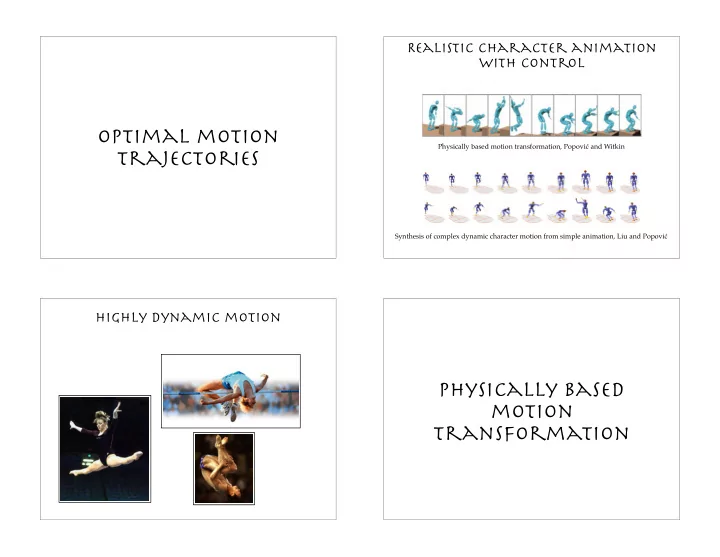

Realistic character animation with control Optimal motion Physically based motion transformation, Popovi � and Witkin trajectories Synthesis of complex dynamic character motion from simple animation, Liu and Popovi � Highly dynamic motion Physically based motion transformation
Motivations High level control Get a limp walk Captured motion by making one leg stiff rich and realistic but hard to edit “moon walk” Motion warping by reducing gravity works well only for small deformations “quite” run no high-level editing constraints by reducing the floor impact forces my advisor New approach Outline complex model Transform existing motion capture sequence Original motion Final motion Spacetime constraints formulation Reconstruction Get the best of both worlds: Fitting Fitting simplified model + expressiveness of captured data controllability of the spacetime model Spacetime motion Transformed model spacetime motion Spacetime editing
Character simplification Approaches DOF reduction improves performance and Simplify character kinematics facilitates convergence Use input motion to construct a spacetime motion The essence of the motion can be better preserved model on a simplified model Simplified kinematics Simplified kinematics Remove irrelevant DOFs Reduce passive body structures to mass points Human run Human jump Exploit symmetric movement of limbs
Motion fitting Degrees of freedom Handle: a property that correlates the original to the Solve for simplified motion constrained by the simplified model handles Solve for muscle forces and contact forces that make the simplified motion satisfy dynamic constraints muscle forces: Q k = k s ( q k − q m ) − k d ( ˙ q k − ˙ q m ) ∂ p contact forces: Q c = q λ ∂ q Constraints Objective function Muscle smoothness q 2 E m = ¨ m Pose constraints Handle similarities Mechanical constraints E d = [ h o ( q o ) − h s ( q s )] 2 Dynamics constraints � � E = w d E d + E m
Motion synthesis as constrained Outline optimization complex model DOFs: joint ( ), muscle ( ), and force ( ) DOFs q k q m q λ Original motion Final motion for simplified model Reconstruction Constraints: pose constraints, mechanical Fitting simplified model constraints, and dynamics constraints + Objective function: muscle smoothness and handle similarities between complex and simplified models Spacetime motion Transformed model spacetime motion Spacetime editing Spacetime editing Spacetime editing Spacetime editing Change pose and environment constraints Change explicit character parameters Foot placements and timing Shorten a leg Introduce a new obstacle Redistribute mass Change the objective function Modify muscle characteristic Minimize floor impact forces Gravity Make dynamic balance more important
Outline Motion reconstruction complex model Three different handle sets Original motion Final motion Original motion handles ( h ( q o )) Reconstruction Reconstruction Spacetime fit handles (simplified model, h ( q s )) Fitting simplified model + Transformed spacetime handles ( h ( q t )) Compute final motion handles Spacetime motion Transformed h ( q f ) = h ( q o ) + ( h ( q t ) - h ( q s )) model spacetime motion Spacetime editing Minimum displaced mass Motion reconstruction E dm ( q o , q ) evaluates the total mass displacement when moving a character from pose q o to pose q For each time t , solve q f that minimizes E dm ( q o , q f ) subject to handle displacement: h ( q f ) = h ( q o ) + ( h ( q t ) - h ( q s )) mechanical and pose constraints: C ( q f ) = 0
Example: human run Example: human broad jump Original model has 59 DOFs Original model has 59 DOFs Simplified model has 19 DOFs Simplified model has 11 DOFs Optimizations are done on one gait cycle Entire upper body reduced to a mass point Each optimization computes within 2 minutes No revolute joint angle Hopper Results input mocap motion simplified motion Fitting Editing Reconstructing reconstructed motion edited motion
Results Discussions input mocap motion simplified motion Fitting If you were the reviewer of this paper, can you think of two reasons to reject this paper? Editing If you were the advisor of the author, what is the next task you would ask the author to do? Reconstructing reconstructed motion edited motion Discussions The model simplification is done in an ad-hoc way. Can you think of an algorithm to do it in a more systematic way? Can this algorithm work with more lethargic or kinematics motion, such as picking up an object? Does this algorithm guarantee physical realism in the reconstructed motion?
Recommend
More recommend